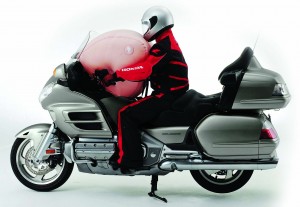The rumors of a new Honda Gold Wing model for 2006 started flying last summer. Would it be sportier yet, with a shorter wheelbase, or have larger luggage and more standard features? Would there be an additional SE version like the last top-line GL1500? An electric windscreen, perhaps, or an automatic transmission?
Apparently Honda still has a few surprises up its collective sleeve, because no one saw coming what we eventually got in the 2006 Gold Wing GL1800. Make that Gold Wings-four versions in five colors with varying levels of factory equipment are all based on the familiar six-cylinder GL1800 platform we’ve known since 2001. The only mechanical changes to it are larger radiators and fans for better cooling and a 200-watt-more-powerful 1,300-watt alternator with a fluid-damped drive. In the styling department, someone was feeling funky and gave the bike clear running-light and rear turn-signal lenses, too. All four models also come with a new Premium Sound System for 2006, which operates from the same control panel on the tank but boosts power from 30 watts up to a booming 80 watts per channel from six larger speakers. Two are standard in the rear now, and there are four in the front, including a pair of tweeters.
Nice changes indeed, and for most riders the base model will satisfy all of their touring needs well into the future. But Honda didn’t stop there. Next up the line is a model with all of the above plus a new Comfort Package, which adds a heated passenger backrest, seats and heated grips, and brings back the slick foot warmers last seen on the GL1500SE. Want more? You can add a GPS Satellite Linked Navigation System to the bike with the Comfort Package, and anti-lock brakes to the Wing with the Navi system. Pricing ranges from $18,999 for the base bike in black to $22,799 for all of the factory options. And then there’s the staggering list of 60-plus dealer options for 2006, including the six-CD changer, CB, passenger armrests and foglights, as well as 19 new ones like the muffler tips on our test bike.
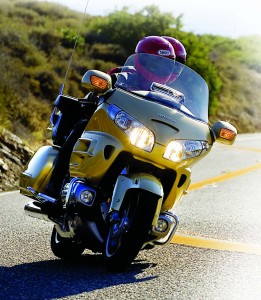
If you’re thinking that Honda is trying an automobile-type “package-upgrade” marketing system with its four Gold Wing editions in 2006, you’d be right. But the coup de gr√¢ce from the car side has got to be the airbag that will be available on the top-line bike in late spring of 2006. Although we don’t yet know what the airbag will add to the cost and weight of the bike, from the literature and videos we’ve seen it appears that it will contribute a significant degree of safety.
The airbag functions just like an automobile version with all of the attendant sensors, computer and inflators, and can help reduce the rider’s velocity as he leaves the bike in a frontal impact (which account for something like 95 percent of all motorcycle accidents that involve another vehicle). The only downside we can see (assuming it doesn’t pop if you hit a curb or a 4×4 and cost a fortune to replace) is that the bag compartment goes on top of the shelter (tank) and takes the place of the audio controls. These are moved to the left side of the fairing, and the suspension and other controls currently there move over to the right and may eliminate the pocket there. We haven’t tried it, but this will probably make the audio controls more difficult to use, and may take away some storage space that is already in short supply.
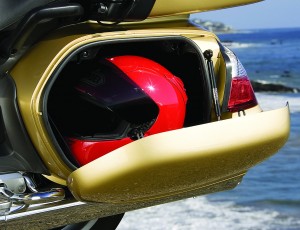
Honda introduced the 2006 Gold Wing in stunning Sedona, Arizona, around which my wife Genie and I made loops two-up for two days and then rode the Wing the 525 miles home. I’ve been commuting and doing weekend rides on the bike in the weeks since, a top-line model with all of the factory options (except the airbag) and a few dealer accessories such as the six-CD changer, foglights and passenger audio controller. After a bumpy one-way flight to Phoenix, it was a treat to load up the familiar Wing with our gear and head north toward Sedona, soaking up some unique Arizona sights like the old mining town of Jerome and Tuzigoot National Monument, the ruins of a Sinaguan Indian village built around 1000 AD.
Having tested this bike extensively in the past (see Rider, October 2004, April 2002 and February 2001), the only performance difference I noticed from earlier examples is that the radiator fans are louder and come on more frequently. Otherwise it is still the abundantly powerful, supremely smooth and comfortable luxury touring bike with which we are familiar, one that handles like a much lighter and smaller sport-touring machine once underway. The linked braking is superb with or without ABS, the suspension compliant and easily adjusted for varying loads and wind and weather protection for the rider excellent.
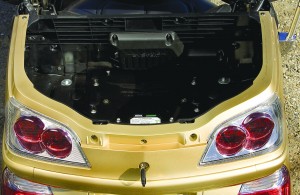
My gripes are the same, too, as the bike still lacks enough storage in the saddlebags and top trunk for long two-up rides (although the optional luggage rack helps here-buy lightweight souvenirs). There is plenty of seating space for larger riders, but average-size passengers sit too far back to benefit completely from the windscreen and fairing and can experience a windier, colder ride than the pilot, who is thoroughly shielded up front. The juxtaposition of the passenger seat and backrest can be uncomfortable for those of average size, too.
Otherwise, it’s hard to fault the fast, fun and well-integrated Wing, and the new stuff we’ll focus on here just makes it even better. Most intriguing on that list is the GPS-satellite-based Navi system, which integrates a large, automotive-style map display into the instrument panel that is bright, sharp and easy to read in nearly all lighting conditions. Voice and visual prompts guide you to your destination as in automotive navigation systems. But instead of slow DVD access, the system database (the 50 states plus Canada, including metro and rural areas) resides on a two-gigabyte Compactflash card, and there are 16 megabytes of system RAM, so it’s very quick to make calculations and update the display. And it’s easy to upgrade the map later, too, as you can just get a new flash card as they come out. The unit’s CPU is in the trunk, and the cards pop into a covered slot in the side. Most of the controls are down on the right side of the fairing and cannot be used while the bike is in motion, though you can scroll through and zoom the display modes and control the voice prompts while underway.
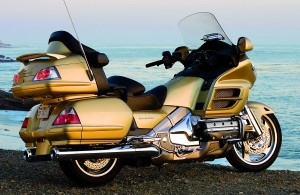
As it’s based upon the system in the Honda Accord, the Wing Navi has all of the features you would expect in an automobile setup, with a couple of minor exceptions. It lacks the ability to store more than one route (though you can store Favorite Places for quickly setting destinations or vias), and loops that begin and end at the same spot cannot be programmed in advance and stored, even when stops along the way are programmed into the loop. Riding groups will have to pick one Navi-equipped bike to follow on a ride, too, unless every rider sets the many route preferences (faster time, shorter distance, toll roads, carpool lanes, etc.) to the defaults, or programs them identically.
I was impressed with the full-color Navi map display, which automatically switches from your choice of khaki, gray, yellow or orange backgrounds in the daytime to a black background at night and has adjustable brightness. The system is thoroughly useful when you don’t know how to get to where you’re going, or would like to learn about some Points of Interest along your route. The voice prompts integrate well with the sound system audio but can be too frequent, so I usually turned them off. Honda (or its lawyers more likely) also insists upon your acknowledging a caution and disclaimer screen by pressing a button every time you turn on the ignition if you wish to use the Navi. Ride off without waiting an interminable 10 seconds for it to display, and you’re locked out of the Navi until the next time you stop the bike. Maybe I’m in too big a hurry much of the time, but the process takes way too long.
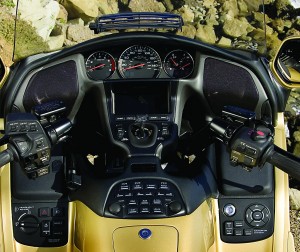
If you enjoy music and an intercom on the road, the new Premium Sound system won’t disappoint. The controls worked well before, and now the sound from the bigger speakers is terrific. Bass-level control is now speed-sensitive, so it can be set to go up with the volume as you pick up the pace. In addition to the optional (and expensive) six-CD changer that goes in the floor of the trunk, you can easily connect an auxiliary audio device like an iPod or a radar detector, and on the bike with Navi the audio functions show up on this larger display. I still found headsets preferable for long rides, but was blown away by the volume and sound quality that the new larger speakers can produce. We didn’t find much use for the optional passenger audio controller, however, as our bike had no CB to try with its PTT button, and the volume control doesn’t make enough of a change to the sound.
Last here but first up on the factory options list is the Comfort Package, the heated seats of which are oddly overdue from a company that has offered them in its cars for some time. Although the rider and passenger have separate controls and the warmth is certainly welcome, neither the seats nor backrest get warm enough for those times when you genuinely need them. The five-position heated grips work fine, though, as do the foot warmers that direct air heated by the engine over your feet when you open them with a lever. Overall I’d say the Comfort Package is the last one you want until the seats work better-too bad you have to have it to get Navi and/or ABS.
